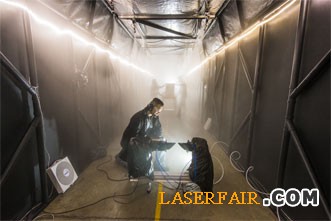
Fog Chamber Aims for Better Optics Testing
source:photonics.com
release:Julie
keywords:
Time:2015-06-24
A humid chamber in the desert of New Mexico is designed to help improve the abilities of cameras and sensors to penetrate fog.
Sandia National Laboratories recently created the chamber — which is 180 feet long, 10 feet tall and 11 feet wide — inside a tunnel owned by the U.S. Air Force Research Laboratory. The chamber is enclosed by air curtains and rubber baffles to entrap the fog. Tunnel walls are painted black to reduce reflection and improve data quality.

Chemical engineer Andres Sanchez checks an instrument that measures the particle size and concentration of fog inside a chamber designed for optical testing. Courtesy of Randy Montoya/Sandia National Laboratories.
Currently, the chamber's fog resembles that found in coastal regions, but output can be customized to produce fog physically similar to that found in any location, said Crystal Glen, an aerosol scientist. Researchers eventually hope to add smoke and dust to the chamber's repertoire.
Until now, collecting field test data in foggy environments was time consuming and costly.
"Fog is difficult to work with because it rarely shows up when needed, it never seems to stay around long enough once you're ready to test and its density can vary during testing," said Rich Contreras, a systems engineer at Sandia.
The chamber also could be used to answer fundamental optics questions, which in time could lead to improved security camera lenses and medical imaging equipment, safer aircraft landings, and better vision for drivers in fog, according to Sandia.
"People need to see through fog," said optical scientist Gabe Birch. "So much of the U.S. population is on the coastlines in places wher fog exists. If you could discover an inexpensive technique to see better through it, there are a lot of people in industry who would be interested in that."
In physical security, Birch said, "the cameras are very sensitive to the sizes of fog particles and how the photons scatter. That's why it's so important to know the sizes of particles that we have in the environment, which is something that we in the optical field have not really had before. It enables a lot of very interesting testing because you can finally characterize your system's performance by knowing the scattering that's happening in the environment."
Examples of tests include showing raw data from various cameras, characterizing how different wavelengths and polarization states are influenced by fog, comparing different optical systems in a controlled foggy environment, and observing how optical properties and imaging resolution degrade in a variety of foggy environments.
"When you look at the huge gap from the visible spectrum all the way up to the far-infrared, no one can say we absolutely understand how the polarization states at all these different wavelengths behave as they go through a foggy atmosphere," Birch said.
Recent research at Sandia has suggested that polarization could be exploited to see better through fog or other scattering environments, according to optical engineer David Scrymgeour. Testing along these lines could inform not only security camera design but also medical imaging.
"The physics in scattering events are the same," he said.
Sandia National Laboratories recently created the chamber — which is 180 feet long, 10 feet tall and 11 feet wide — inside a tunnel owned by the U.S. Air Force Research Laboratory. The chamber is enclosed by air curtains and rubber baffles to entrap the fog. Tunnel walls are painted black to reduce reflection and improve data quality.

Chemical engineer Andres Sanchez checks an instrument that measures the particle size and concentration of fog inside a chamber designed for optical testing. Courtesy of Randy Montoya/Sandia National Laboratories.
Currently, the chamber's fog resembles that found in coastal regions, but output can be customized to produce fog physically similar to that found in any location, said Crystal Glen, an aerosol scientist. Researchers eventually hope to add smoke and dust to the chamber's repertoire.
Until now, collecting field test data in foggy environments was time consuming and costly.
"Fog is difficult to work with because it rarely shows up when needed, it never seems to stay around long enough once you're ready to test and its density can vary during testing," said Rich Contreras, a systems engineer at Sandia.
The chamber also could be used to answer fundamental optics questions, which in time could lead to improved security camera lenses and medical imaging equipment, safer aircraft landings, and better vision for drivers in fog, according to Sandia.
"People need to see through fog," said optical scientist Gabe Birch. "So much of the U.S. population is on the coastlines in places wher fog exists. If you could discover an inexpensive technique to see better through it, there are a lot of people in industry who would be interested in that."
In physical security, Birch said, "the cameras are very sensitive to the sizes of fog particles and how the photons scatter. That's why it's so important to know the sizes of particles that we have in the environment, which is something that we in the optical field have not really had before. It enables a lot of very interesting testing because you can finally characterize your system's performance by knowing the scattering that's happening in the environment."
Examples of tests include showing raw data from various cameras, characterizing how different wavelengths and polarization states are influenced by fog, comparing different optical systems in a controlled foggy environment, and observing how optical properties and imaging resolution degrade in a variety of foggy environments.
"When you look at the huge gap from the visible spectrum all the way up to the far-infrared, no one can say we absolutely understand how the polarization states at all these different wavelengths behave as they go through a foggy atmosphere," Birch said.
Recent research at Sandia has suggested that polarization could be exploited to see better through fog or other scattering environments, according to optical engineer David Scrymgeour. Testing along these lines could inform not only security camera design but also medical imaging.
"The physics in scattering events are the same," he said.
MOST READ
- RoboSense is to Produce the First Chinese Multi-beam LiDAR
- China is to Accelerate the Development of Laser Hardening Application
- Han’s Laser Buys Canadian Fiber Specialist CorActive
- SPI Lasers continues it expansion in China, appointing a dedicated Sales Director
- Laser Coating Removal Robot for Aircraft
PRODUCTS
 FISBA exhibits Customized Solutions for Minimally Invasive Medical Endoscopic Devices at COMPAMED in
FISBA exhibits Customized Solutions for Minimally Invasive Medical Endoscopic Devices at COMPAMED in New Active Alignment System for the Coupling of Photonic Structures to Fiber Arrays
New Active Alignment System for the Coupling of Photonic Structures to Fiber Arrays A new industrial compression module by Amplitude
A new industrial compression module by Amplitude Menhir Photonics Introduces the MENHIR-1550 The Industry's First Turnkey Femtosecond Laser of
Menhir Photonics Introduces the MENHIR-1550 The Industry's First Turnkey Femtosecond Laser of Shenzhen DNE Laser introduced new generation D-FAST cutting machine (12000 W)
more>>
Shenzhen DNE Laser introduced new generation D-FAST cutting machine (12000 W)
more>>
